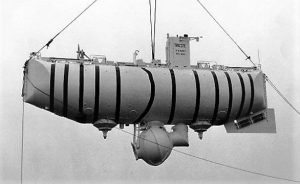Bathyscaphe
In underwater world exploration, the bathyscaphe is one of the most widely used vehicles because of its design and its ability to explore the deep sea, withstanding the high pressures of the ocean.

Key questions
- What type of vehicle is it? Submersible
- Who invented it? Augusto Picard
- In what year was the first one manufactured? 1937
- How deep can it descend? More than 11 000 meters
Related Topics
Submarine
What is the bathyscaphe?
The bathyscaphe is a submersible vehicle designed to explore sea depths and withstand high pressures. Its name comes from ancient Greek and means deep boat. This submersible boat was invented by Auguste Picard and his first dive was in 1948, in Cape Verde, reaching a depth of 1080 meters. Today, there are bathyscaphs that can descend 11,000 meters deep. Bathyscaphs have a propulsion that allows them to dive thousands of meters deep. Thanks to a ballast made of lead spheres and a gasoline cistern or a liquid lighter than water, it can descend to depths and float when it emerges to the surface. These boats can be manned by one or more people and are equipped with technologies that allow you to record, measure and even rescue objects from the bottom of the sea thanks to their mechanical arms.
This minisub marine has been very useful for nautical research as it comes equipped with cameras and other tools that can record, measure and even rescue objects from the bottom of the sea.
It should not be confused with the submarine because, submarines can only reach a depth of 1500 meters, while the bathyscaphe can currently reach up to 11,000 meters deep.
History of the bathyscaphe
It was designed by August Picar, a Swiss physics professor who wanted to create a submarine vessel that could move deep in the sea without using cables.
The first was made in 1937, had a spherical shape and weighed 15 tons. It was fitted with a tank full of gasoline to help the bathyscaphe float. The bathyscaphe carried lead spheres to descend to the depth and two propellers to move in any direction.
In 1948, tests were carried out on an unmanned bathyscaphe. This was submerged up to 1,500 meters, but when a hurricane that was happening at that moment came out, it caused serious damage to the ship.
In 1953, Picard created the “Trieste” in Italy, another bathyscaphe that managed to descend to a depth of 3,500 meters in the Gulf of Naples. This time, the boat was crewed by Picard’s son, Jacques Picard.
Six years later the “Trieste” was renovated and tested in the Pacific Ocean sea trenches between the Philippines and Japan. The bathyscaphe broke its old record by descending to a depth of 11,000 meters.
Characteristics of the bathyscaphe
Among the most outstanding characteristics can be mentioned:
- Its resemblance to a mini submarine without being a submarine.
- It can be crewed by one or more people.
- The crew cabin contains air at normal atmospheric pressure.
- Its accessories such as cameras, mechanical arms and other technological tools allow it to collect objects, measure, record and store information at great depths.
- Its ability to descend to sea depths that can currently reach 11,000 meters deep.
- Its cabin is suspended under a tank that contains a liquid lighter than water, such as gasoline.
- It has no cables to connect it to another vessel on the surface or on land.
- Its electric propulsion motors allow you to move in the direction you want.
Uses
Bathyscaphe has always been used for underwater exploration because it reaches depths that the submarine has not been able to achieve. Its design and size allows access to smaller spaces than other types of ships, and its technological accessories are very useful for collecting information, either in data or physical objects that are submerged to be studied later on the surface.
How does the bathyscaphe work?
It is a boat that works with certain elements that allow it to descend or float in water and other elements that allow it to move.
This type of vehicle has a weight distributed in a ballast formed by lead spheres that allow it to dive into the depths. Its original weight was 15 tons, but today this weight varies depending on the model.
It also has a cistern filled with gasoline, a liquid lighter than water, which will allow you to float whenever you want to surface by releasing the lead weights that made you submerge.
The gasoline tank located at the bottom of the bathyscaphe allows the fuel to make contact with water and gradually take up the pressure of the underwater environment in which it is immersed.
It also has propellers that allow it to move forward and backward in different directions.
How to cite this article?
Briceño V., Gabriela. (2019). Bathyscaphe. Recovered on 24 February, 2024, de Euston96: https://www.euston96.com/en/bathyscaphe/









